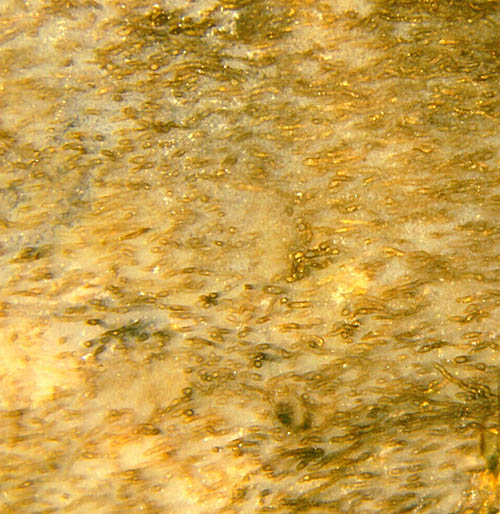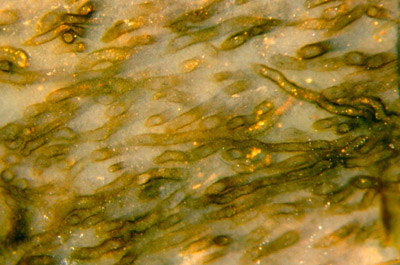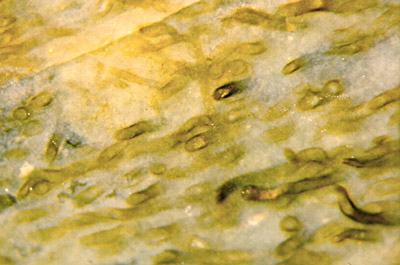Another weft of tubes -
another
nematophyte ?
There are peculiar fossils consisting of a weft of tiny flexible tubes.
The various species found worldwide have been compiled under the name
nematophytes.
They are of particular interest as they are thought to
belong to the earliest land plants and have not yet got a
position in the phylogenetic tree.
Such kind of fossil has been found recently in a small sample (0.25kg)
from Rhynie, where it appears as a "composite material" consisting of
tubes in a matrix of siliceous or organic gel. Fragments thereof had
lain in the swamp, together with land plants of the Rhynie flora. All
silicified into chert. The outer boundary of
the weft was either not on the present fragment or had been
eroded away before silicification ***.
The tubes are rather evenly arranged
on a large scale and randomly in detail
(Fig.1) except for the presence
of a few tangled "knots" as in Fig.2, whose purpose and inner structure
are enigmatic. The orientation of the tubes is not
random but shows a tendency towards a texture.

Fig.1: Weft of flexible tubes in Rhynie
chert, rather evenly distributed except for
tangled knots as the one seen below right. Width of the
picture 5.5mm.

Fig.2: Tangled knot of tubes on the right,
detail of Fig.1.
Width of the picture 2mm.
From the deformation of some
tubes at positions of mutual contact, as in Fig.2, above left, it can
be
concluded that the tubes were rather limp before silicification.
The diameter of the tubes is about 50 to 70Ám. None of the tubes shows
the spiral or annular wall pattern often seen in nematophytes. The
tubes do not seem to be branched or subdivided into cells, perhaps with
rare exceptions as in Fig. 3, where a tube seems to branch and form a
larger bud**. However, this particular tube is exceptionally thin
(35Ám)
and runs athwart the texture, so it is not certain whether it belongs
to the weft.

Fig.3 (right): Weft of tubes with one
particular tube deviating in size, shape, and orientation (above
centre). Note the outgrowth resembling a bud on a stalk.
All pictures have been taken from the natural
surface of the sample.
With these features, the fossil differs distinctly from the two
nematophyte species found at Rhynie before [1,2,3] and also from
several others found elsewhere [4,5], and thus the question arises
whether it is a nematophyte at all. It is roughly similar to the dense
tufts of rhizoids below the rhizome of Horneophyton. Those rhizoids,
however, are much thinner (25Ám) and more straight and aligned. An
interpretation as a tuft of rhizoids of a larger, still unknown plant
can be ruled out with the argument that it would be against
the nature of rhizoids to form tangled knots as in Fig.2.
This loose aggregate of limp tubes could hardly be mechanically stable
like a felt: When moistened it would likely collapse under the action
of surface tension like a fluff of cotton. However, this would not mean
that the delicate
structure must have grown under water. The space between the tubes
could have been filled with a gelatinous substance providing
stability,* as it is known from various algae and cyanobacteria. This
would also explain
why there were no tiny bits of debris like spores or microbial clots
between the tubes although such dirt was omnipresent in the swamp water
where the Rhynie chert formed. (A granular structure faintly seen in
some places may be an artifact due to crystallization.) So it seems
that the statement “habitat probably subaerial” made in [5] for all
nematophytes might well apply to this organism, too.
* More evidence for gel
in nematophytes has become available from
own finds.
** Up to now (2020), no other outgrowth resembling a bud has been found.
*** ... with important exceptions recognized as such in 2016, see Rhynie Chert
News 98,
155
H.-J.
Weiss
2005, emended 2013 2020
[1] www.abdn.ac.uk/rhynie
[2] R.
Kidston, W.H. Lang: On Old Red Sandstone plants
showing structure, Part V.
Trans. Roy. Soc. Edinburgh
52(33)(1921): 855-902.
[3] A.G.
Lyon: On the fragmentary remains of an organism
referable to the Nematophytales,
Trans. Roy. Soc. Edinburgh
65(4)(1962): 79-87.
[4] P.K.
Strother: New species of Nematothallus, J.Paleont.
62(1988), 967-982.
[5] P.K.
Strother: Clarification of the genus Nematothallus
Lang,
J.Paleont. 67(1993), 1090-94.
 |
 |
13 |






